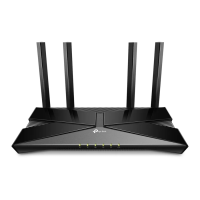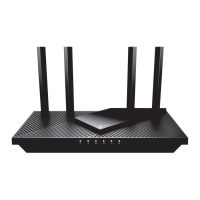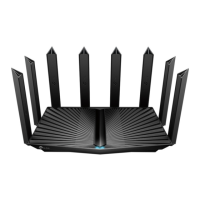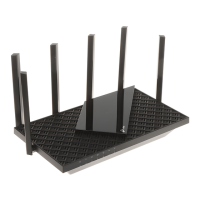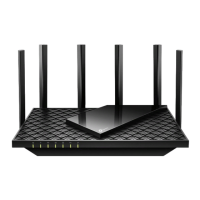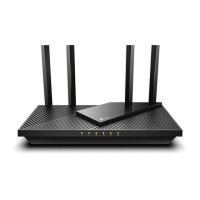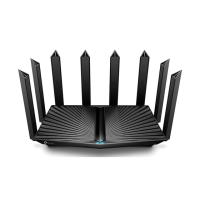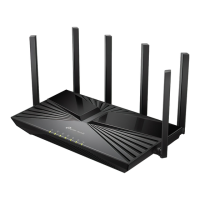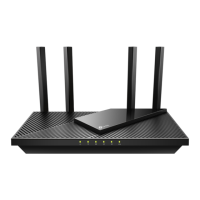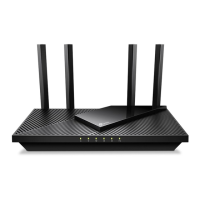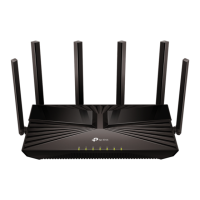Do you have a question about the TP-Link Archer AX23 and is the answer not in the manual?
Details the router's advanced Wi-Fi 6 technology, OFDMA, and 1024QAM for improved performance and efficiency.
Describes the router's physical appearance, including the top panel and LED indicators for status explanation.
Provides essential guidelines for placing the router to ensure optimal performance and avoid damage from heat or interference.
Outlines the step-by-step process for connecting the router to your modem and power source, including wired and wireless connection methods.
Guides users through the router's Quick Setup Wizard for easy internet connection configuration.
Explains how to manually configure internet connection settings like Dynamic IP, Static IP, and PPPoE.
Provides instructions on how to register a TP-Link ID for cloud management and enhanced router features.
Details how to add or remove TP-Link IDs to manage the router, distinguishing between Admin and User roles.
Covers changing SSID, password, security options, and enabling Smart Connect for wireless networks.
Explains how to use WPS to easily and securely connect wireless devices to the router.
Guides on creating a separate Wi-Fi network for guests, customizing SSID, security, and password.
Details how to block inappropriate content and control internet access for family members based on profiles and time limits.
Instructions on setting up a unified Wi-Fi network using TP-Link OneMesh routers and extenders for seamless coverage.
Explains the SPI Firewall's role in protecting the network from cyber attacks and validating traffic.
Details how to block or allow specific devices to access the network using Blacklist or Whitelist modes.
Guides on configuring port forwarding to share local network services like websites or FTP servers on the internet.
Explains how to set up a DMZ host to bypass port restrictions for applications like online gaming.
Instructions for configuring the router as an OpenVPN server to enable secure remote access to the home network.
Details how to change the router's LAN IP address and subnet mask to avoid conflicts or meet network requirements.
Explains how to configure the DHCP server to assign IP addresses and reserve IP addresses for specific devices.
Guides on performing online or local updates to keep the router's firmware current for optimal performance and security.
Instructions for backing up current router settings to a file and restoring them later, including factory resets.
Details on how to change the password used to log in to the router's web management interface for security.
Explains how to limit router access to specific devices on the LAN using MAC address authentication.
Guides on enabling and configuring remote access to manage the router from outside the local network.
Instructions on saving system logs locally or sending them to an email address for troubleshooting and status monitoring.
Explains how to use Ping and Traceroute tools to diagnose and test network connectivity issues.
Details on setting the router's system time, time zone, and display language for proper operation and time-based features.
Instructions for scheduling automatic router reboots to maintain performance and clear cache.
Guides on controlling router LEDs, including enabling Night Mode to turn them off during specified periods.
Details the router's advanced Wi-Fi 6 technology, OFDMA, and 1024QAM for improved performance and efficiency.
Describes the router's physical appearance, including the top panel and LED indicators for status explanation.
Provides essential guidelines for placing the router to ensure optimal performance and avoid damage from heat or interference.
Outlines the step-by-step process for connecting the router to your modem and power source, including wired and wireless connection methods.
Guides users through the router's Quick Setup Wizard for easy internet connection configuration.
Explains how to manually configure internet connection settings like Dynamic IP, Static IP, and PPPoE.
Provides instructions on how to register a TP-Link ID for cloud management and enhanced router features.
Details how to add or remove TP-Link IDs to manage the router, distinguishing between Admin and User roles.
Covers changing SSID, password, security options, and enabling Smart Connect for wireless networks.
Explains how to use WPS to easily and securely connect wireless devices to the router.
Guides on creating a separate Wi-Fi network for guests, customizing SSID, security, and password.
Details how to block inappropriate content and control internet access for family members based on profiles and time limits.
Instructions on setting up a unified Wi-Fi network using TP-Link OneMesh routers and extenders for seamless coverage.
Explains the SPI Firewall's role in protecting the network from cyber attacks and validating traffic.
Details how to block or allow specific devices to access the network using Blacklist or Whitelist modes.
Guides on configuring port forwarding to share local network services like websites or FTP servers on the internet.
Explains how to set up a DMZ host to bypass port restrictions for applications like online gaming.
Instructions for configuring the router as an OpenVPN server to enable secure remote access to the home network.
Details how to change the router's LAN IP address and subnet mask to avoid conflicts or meet network requirements.
Explains how to configure the DHCP server to assign IP addresses and reserve IP addresses for specific devices.
Guides on performing online or local updates to keep the router's firmware current for optimal performance and security.
Instructions for backing up current router settings to a file and restoring them later, including factory resets.
Details on how to change the password used to log in to the router's web management interface for security.
Explains how to limit router access to specific devices on the LAN using MAC address authentication.
Guides on enabling and configuring remote access to manage the router from outside the local network.
Instructions on saving system logs locally or sending them to an email address for troubleshooting and status monitoring.
Explains how to use Ping and Traceroute tools to diagnose and test network connectivity issues.
Details on setting the router's system time, time zone, and display language for proper operation and time-based features.
Instructions for scheduling automatic router reboots to maintain performance and clear cache.
Guides on controlling router LEDs, including enabling Night Mode to turn them off during specified periods.
| DSL WAN | - |
|---|---|
| Ethernet WAN | Yes |
| WAN connection type | RJ-45 |
| Product type | Tabletop router |
| Product color | Black |
| Wi-Fi band | Dual-band (2.4 GHz / 5 GHz) |
| Wi-Fi standards | 802.11a, 802.11b, 802.11g, Wi-Fi 4 (802.11n), Wi-Fi 5 (802.11ac), Wi-Fi 6 (802.11ax) |
| Top Wi-Fi standard | Wi-Fi 6 (802.11ax) |
| WLAN data transfer rate (max) | 1800 Mbit/s |
| WLAN data transfer rate (first band) | 574 Mbit/s |
| WLAN data transfer rate (second band) | 1201 Mbit/s |
| Antenna connector type | SMA |
| Networking standards | IEEE 802.11a, IEEE 802.11ac, IEEE 802.11ax, IEEE 802.11b, IEEE 802.11g, IEEE 802.11n |
| Ethernet LAN data rates | 10, 100, 1000 Mbit/s |
| Ethernet LAN interface type | Gigabit Ethernet |
| Certification | FCC, CE, RoHS |
| Processor cores | 2 |
| Processor frequency | 1500 MHz |
| Output current | 1 A |
| Output voltage | 12 V |
| Power source type | DC |
| Windows operating systems supported | Windows 10, Windows 10 Education, Windows 10 Education x64, Windows 10 Enterprise, Windows 10 Enterprise x64, Windows 10 Home, Windows 10 Home x64, Windows 10 IOT Core, Windows 10 IoT Enterprise, Windows 10 Pro, Windows 10 Pro x64, Windows 2000, Windows 2000 Professional, Windows 7, Windows 7 Enterprise, Windows 7 Enterprise x64, Windows 7 Home Basic, Windows 7 Home Basic x64, Windows 7 Home Premium, Windows 7 Home Premium x64, Windows 7 Professional, Windows 7 Professional x64, Windows 7 Starter, Windows 7 Starter x64, Windows 7 Ultimate, Windows 7 Ultimate x64, Windows 7 x64, Windows 8, Windows 8 Enterprise, Windows 8 Enterprise x64, Windows 8 Pro, Windows 8 Pro x64, Windows 8 x64, Windows 8.1, Windows 8.1 Enterprise, Windows 8.1 Enterprise x64, Windows 8.1 Pro, Windows 8.1 Pro x64, Windows 8.1 x64, Windows 98SE, Windows Vista, Windows Vista Business, Windows Vista Business x64, Windows Vista Enterprise, Windows Vista Enterprise x64, Windows Vista Home Basic, Windows Vista Home Basic x64, Windows Vista Home Premium, Windows Vista Home Premium x64, Windows Vista Ultimate, Windows Vista Ultimate x64, Windows Vista x64, Windows XP, Windows XP Home, Windows XP Home x64, Windows XP Professional, Windows XP Professional x64 |
| USB 2.0 ports quantity | 1 |
| Ethernet LAN (RJ-45) ports | 4 |
| Cables included | LAN (RJ-45) |
| Package depth | 350 mm |
| Package width | 500 mm |
| Package height | 395 mm |
| Package weight | 730 g |
| NAT functionality | Port Forwarding, Port Triggering, UPnP, DMZ |
| Security algorithms | 64-bit WEP, 128-bit WEP, WMM, WPA, WPA-PSK, WPA2, WPA2-PSK |
| Harmonized System (HS) code | 85176990 |
| Operating temperature (T-T) | 0 - 40 °C |
| Operating relative humidity (H-H) | 10 - 90 % |
| Depth | 135 mm |
|---|---|
| Width | 260.2 mm |
| Height | 41.6 mm |
